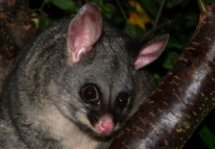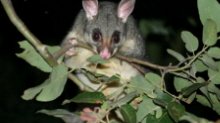Leadbeaters Possum
The Leadbeaters Possum is the Victoria Animal Emblem
They are a small, agile, nocturnal marsupial and are very rarely seen.
They were named after John Leadbeater, who was a taxidermist at the Museum of Victoria.
Their body and tail are grey, with a black stripe from the forehead down the back; there is also a black stripe on each cheek, with a white underbelly.
They measure about 300 millimetres in length, half of this is tail, and they weigh about 100 to 170grams.

They live in small family colonies of up to 8 individuals. The colony is made up of family members and sometimes one or two unrelated males. The senior female is the main defender of the colony. All colony members sleep together in a nest made out of shredded bark in a tree hollow, up to 30 metres above ground level.
They were first discovered in 1867 but by the early 1900's no further animals had been found and they were thought to be extinct until a colony was discovered near Marysville, in the Upper Yarra Valley in 1961.

They need a forest containing mountain ash trees with hollows in which to nest and an understorey, (a layer of small trees, shrubs and herbs under the forest canopy) which contains wattles and acacia.
They eat mainly insects like spiders, crickets and beetles, as well as sap and sweet secretions from trees and insects.
Breeding time is any time of year except January and February. Between one and two young are born and are weaned at about three months. Little else is known, yet, about their reproductive habits.
Leadbeaters Possums can only be found in the Central Highlands of Victoria.
Possums are a protected species in Australia.
The Leadbeaters Possum was proclaimed the Victoria
Animal Emblem in 1971
Go to next animal page: The Quokka
Return to Australian Animals or Australian Animal Emblems
Return from Leadbeaters Possum to Australian-Information-Stories home page


